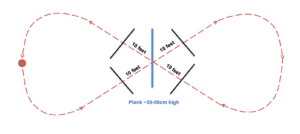Having covered off the Basics of Pole Work and some exercises for Building Strength and Suppleness, these exercises are designed for developing adjustability in the stride (particularly canter) and riding accurate lines and distances.
If you and your horse jump, these exercises can be converted into small jumps once you have ridden them as poles on the ground.
Tip for cantering over poles
All these exercises are designed for or can be ridden in canter. When cantering over a pole, your horse’s hind legs should be on one side of the poles and fore legs on the other – like a jump but without leaving the ground! If you are finding it challenging to get the right distance to the pole, first make sure your canter is forward, but balanced, into the bridle – not too strong and not too weak. Then, instead of aiming for the pole itself, aim for the spot on the other side of the pole where your horse’s forelegs will land. Make sure your eyes are looking ahead for this early as you would to a jump – look over your shoulder rather than waiting until you are lined up with the pole.
2 poles on a straight line
A very simple setup but not necessarily easy to ride, this exercise tests your adjustability in the canter and helps develop your eye for a distance.
Setup
Place two poles 18 metres (60 feet/20 paces) apart.

Riding the exercise
Create a quality working canter that’s in front of the leg but balanced. Approach the poles in a straight line, riding to the centre of each pole. Count your strides between the poles – this doesn’t include the ‘landing’ of your horse’s forelegs after the first pole or the ‘take off’ of your horse’s hind legs before the second pole. Keep your body in left or right canter position (depending which lead you are on) to make sure your horse doesn’t change leads.
Once you know what distance is comfortable for your horse, shorten the canter in order to fit in an extra stride. Make sure you shorten the canter well before the poles, so you can keep an even rhythm, rather trying to bring your horse back at the last minute. To maintain the short canter without strangling it, think ‘ask, release, ask, release’ with your fingers and seat.
After fitting in an extra stride, go back to your original distance. This will probably feel a little long now, so you will have to work to increase the stride length before the poles. The final step is to lengthen the canter and remove a stride from the original distance.
Once you can do this comfortably, your next challenge is to add or remove two strides instead of one!
Clock face
The clock face is great practice for maintaining an even rhythm, bend and length of stride, as well as honing your eye for a distance.
Setup
Place four poles on a 20 metre circle at 12, 3, 6 and 9 o’clock. For green horses, you can start with just two poles at 12 and 6 o’clock before adding the others.

Riding the exercise
First, trot the exercise on both reins to find your line, ensuring you ride to the centre of each pole. As you trot each pole, look around the circle to the next one to ensure a good line and distance. Keep your outside leg back and inside leg on the girth to maintain the bend.
Once ready to canter, establish a good rhythm by circling outside the poles before bringing your horse onto the circle. You should start to find an even number of strides between each pole to help you get into a rhythm.
Clover leaf
The clover leaf exercise has similar benefits to the clock face but allows you to alternate between straight lines and bending – especially good for horses who get strong or keen over poles and jumps. It’s less intense for the horse, but can feel a little complicated for the rider until you get the hang of it!
Setup
Place four poles in a cross with some space in the middle, as per diagram.

Riding the exercise
If you have never ridden this exercise before, it’s best to start in trot so you know where you are going! If heading clockwise over the poles, trot straight over the first pole before turning to the left to circle back and trot the next pole.
Once in canter, be sure to setup a rhythmic, balanced canter beforehand and maintain the correct canter lead position in your legs and hips to prevent your horse from changing leads. The ¾ circles between help bring your horse back to you, bend and use their hind quarters after the straight line.
Bonus exercise: square and plank
This exercise is particularly useful for jumping, but an effective exercise for any horse. I use it for straightness, lead changes, and making sure the horse is waiting and staying soft, to sit and turn after the fence.
Setup
Four poles in a square, 3 metres (10 feet) apart from each other, and a plank diagonally across the middle.

Riding the exercise
First make sure the horse is jumping the plank happily by trotting down between the poles to jump the plank straight. Then establish a nice connected canter and ride the exercise as per the red line. Treat the poles as placing poles, the only difference is that the jump is on an angle. You might find it easier to do the exercise in trot to begin with.
Tips
- Look ahead! It comes up very quickly and you’ll have no chance of riding nice lines unless you are looking where you are going next.
- Start asking for your new canter lead as you are cantering the pole before the plank, but keep your horse straight and make sure you don’t disrupt their rhythm.
- Your horse should get the change over the pole or as they come into the turn after the pole. If not, do a quick simple change through trot or walk and keep going.
- Keep your outside rein on landing to stay out on your line – don’t let your horse fall in and start the turn too early.
- If it’s a bit messy to begin with…keep going! You should both start to get into a rhythm after going through a few times.


